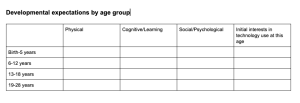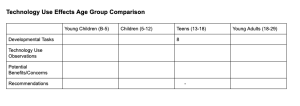Chapter 5: Technology Use and Impacts in Children, Youth and Young Adults
Developmental observations
This chapter highlights four domains of human development across four stages of childhood. To observe children’s technology use with an eye to developmental impact, having a shorthand table can help. Many summaries of human development in children exist online. You can also create one using this table. Go to the Google doc and create a copy:

It can be helpful to use an observation guide to compare and contrast technology use and possible impacts across age groups. A guide (such as the one below) enables you to observe use, within the context of the child. Doing this will help identify some of the traditional factors that motivate children’s use (e.g., using it with peers, using it in school). Go to the Google doc and create a copy:

Readiness to possess a smartphone
Debate the question: Children should not be allowed to possess* a smartphone below the age of 12.
*possess= have complete independent use of, beyond the cost of purchase. Possession may or may not involve covering or contributing to the cost of maintenance (e.g., data plans).
Identifying the pros and cons of this prompt should create a sense of the developmental and practical and social reasons children “possess” phones. A key is to understand children’s readiness and ability to handle what they may be exposed to through 24/7 access to the internet, social media, and apps. They also need to be responsible for maintaining and keeping safe a piece of technology.
Some resources (see chapter text for more references; also the Additional Resources and Materials for Chapter 5):
- Have smartphones destroyed a generation? (Atlantic Monthly, Sept 2017).
- What’s the right age for a child to get a smartphone? (New York Times, 2016)
- What age should a kid get their first phone? (Washington Post, October 2022)
Smartphones in the classroom: Policy discovery
Begin by reading this news item: https://www.edsurge.com/news/2022-06-06-the-case-for-making-classrooms-phone-free?mc_key=00Qi000001X2OYEEA3
Scenario: You teach English at an urban public high school of about 2,000 students. Of the five classes you teach each day, each has an average of 28 students. Two classes are for junior and senior IB/AP students; two classes are for sophomores (a very mixed class), and one for freshman (first-year students, most of whom are from immigrant families where English is not spoken at home).
You attend a Parent-Student-Teacher Association (PTSA) meeting and hear a demand from some teachers for students NOT to have phones available during classes. Currently, the policy by the school and the school district is vague; it primarily encourages “responsible use” and “individual preference by instructors.” Many of the parents agree with the ban, as do a few of the students present. But not all of the students agree. And several teachers of upper-grade students advocate that phones be available for learning purposes. The principal has asked you to lead a work group to identify policies on phones from high schools. The aim will be to present policy options to the PTSA and the student body for creation of a policy, which will then be brought to the school district for adoption.
- Identify examples of policy that can be presented to the school.
- Given parents’ concerns for their children’s exposure to the internet and social media, and the potential value of them having a smartphone, provide a list of recommendations for families in determining children’s safe and effective use of a smartphone. Consult with parents if you like. Write the list as a handout that might be shared by parenting educators.
Technology use by young children in early care and education
Early childhood teachers and child care providers often grapple with whether to teach young children using technology, and with the degree to which iPads, media, YouTube channels, and apps should figure into the day of learning. This list of reflection questions is great for honing in on the intentions behind teaching young children and the use of technology:
Guidelines for Incorporating Technology: Self-Reflection https://www.virtuallabschool.org/fcc/creative-expression/lesson-2/act/25181
Book review
Amazon and other booksellers are full of books about children using technology. Here are a few:
- The wired child: Reclaiming childhood in a digital age. (2015). Richard Freed.
- Glow kids: How screen addiction is hijacking our kids — and how to break the trance. Nicholas Kardaras.
- The big disconnect: Protecting childhood and family relationships in the digital age (2013). Catherine Steinger-Adair.
- How to stay safe on social media: Social media do’s and don’ts: What kids and parents should know. (2021). Effie Manolas.
Choose one of these titles and read it carefully. If you were to write a review of the book for a) family professionals and b) parents, what would write? Strive for a critical eye; remember that reviews often lead readers to consume or ignore a source, and that few publications are perfect just as they are. What should readers attend to? What would readers find most meaningful?
Recommendations for healthy technology use by emerging adults
The aims of young adult development are characterized by
- healthy body and mind
- exploration and identity
- Individuation
- family connectedness and separateness
- feeling stable, less ambivalent
- taking on “full responsibilities of adulthood”
Considering these aims, and your own experiences of and goals for your growing sense of yourself as an adult, what are guidelines you’d recommend for healthy technology use for your age group? Join with a group of peers and create a list of recommendations. Engage in a dialogue about the challenges you face in your technology use and in taking on the “full responsibilities of adulthood” to prepare a realistic and constructive list.

